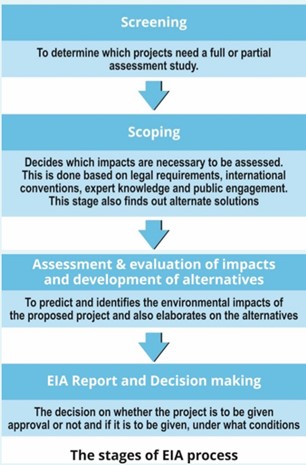-
Q. Environmental Impact Assessment (EIA) reconciles the need for economic growth with environmental preservation. Comment. (250 Words)
21 Feb, 2024 GS Paper 3 Bio-diversity & EnvironmentApproach
- Give a brief Introduction to Environmental Impact Assessment (EIA).
- Discuss the role of Environmental Impact Assessment (EIA) in reconciling economic growth with environmental preservation.
- Discuss the shortcomings of Environmental Impact Assessment (EIA) in India.
- Conclude suitably.
Introduction
The EIA, as defined by the United Nations Environment Programme (UNEP), is a crucial tool for assessing the environmental consequences of projects before they are executed. It involves comparing project alternatives, predicting environmental impacts, and formulating mitigation strategies. It is issued under the Environmental (Protection) Act, 1986.
Body
Role of EIA in reconciling economic growth with environmental preservation :
- Comprehensive Evaluation: EIA systematically assesses the potential environmental impacts of proposed projects, providing decision-makers with crucial information to balance economic development goals with environmental concerns.
- Informed Decision-Making: By quantifying environmental consequences such as pollution and habitat destruction, EIA enables policymakers to make informed decisions that minimize negative impacts on the environment while still promoting economic growth.
- Stakeholder Engagement: EIA involves stakeholders, including local communities and environmental advocates, in the decision-making process. This participatory approach ensures that diverse perspectives are considered and environmental interests are safeguarded.
- Mitigation Measures: EIA recommends mitigation measures and alternative approaches to minimize environmental harm. For example, it may suggest the use of cleaner technologies or the preservation of ecologically sensitive areas, allowing for sustainable development practices.
- Promotion of Sustainable Development: By integrating environmental considerations into project design, EIA promotes sustainable development that balances economic, environmental, and social priorities.
The shortcomings of Environmental Impact Assessment (EIA) in India include:
- A Time-Consuming Process: The EIA process, which is sometimes excessively focused on scientific investigation, takes time and causes project delays.
- Limited Public Participation: While EIA regulations mandate public consultation, meaningful participation by affected communities and stakeholders may be lacking.
- Inadequate Baseline Data: EIA often relies on baseline data to assess environmental impacts accurately. However, in many cases, baseline data in India may be incomplete or outdated, leading to inaccuracies in impact assessments.
- Political Interference: There have been instances of political interference in the EIA process, where decisions may be influenced by vested interests rather than scientific evidence or environmental considerations.
To improve the Environmental Impact Assessment (EIA) process in India, several measures can be undertaken:
- Independent Review and Monitoring: An independent regulator could help ensure a more equitable balance between development and environmental preservation.
- Conduct regular monitoring and evaluation of approved projects to assess compliance with mitigation measures and environmental regulations.
- Utilize Technology to Enhance Data Collection and Analysis: Invest in comprehensive data collection and analysis methods to ensure accurate baseline data and robust impact assessments.
- This may involve conducting thorough environmental surveys and utilizing advanced technologies such as remote sensing and GIS.
- Transparency and Public Participation: Increase transparency in the EIA process by making project documents and decisions easily accessible to the public.
- Encourage active participation of stakeholders, including local communities, NGOs, and experts, through public consultations, hearings, and feedback mechanisms.
- Continuous Improvement and Learning: Foster a culture of continuous improvement and learning within the EIA community by sharing best practices, lessons learned, and success stories.
Conclusion
By providing decision-makers with information about the potential environmental impacts of development activities and promoting stakeholder engagement and mitigation measures, EIA will help ensure that economic growth is pursued in a manner that is environmentally sustainable and socially responsible.
To get PDF version, Please click on "Print PDF" button.
Print PDF





